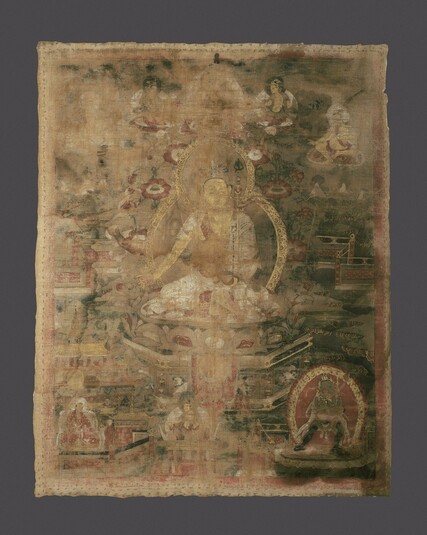
Item: Teacher (Lama) - Tsang Nyon Heruka
| Origin Location | Tibet |
|---|---|
| Date Range | 1500 - 1599 |
| Lineages | Drukpa (Kagyu) and Buddhist |
| Material | Ground Mineral Pigment on Cotton |
| Collection | Margot and Tom Pritzker |
Tsang Nyon Heruka (1452-1507), author, teacher and yogi, in mahasiddha appearance.
Tsang Nyon appears as a Tantric yogi holding a vajra scepter in the extended right hand and a skullcup in the left with a katvanga staff leaning against the left shoulder. His robe is white as is the custom of those following the tradition of Milarepa and Rechungpa. A wide red meditation belt crosses his chest descending from right to lower left. With the legs in a relaxed manner, he is seated atop a moon disc and multi-coloured lotus throne surrounded by two spheres of ornate golden light.
Typically Tsang Nyon wears a skull headdress and bone ornaments modelling the appearance of the semi-peaceful and semi-wrathful deities like Hevajra and Chakrasamvara of the Anuttarayoga class of Buddhist Tantra. This is known as Mahasiddha Appearance. This peculiar and anti-social manner of dressing, copying a Heruka deity, is called the second level of the Application of the Vow in the Hevajra Tantra. The Chakrasamvara and Hevajra Tantras principally, along with similar instructions in other Tantras, are the textual source for all of those teachers and practitioners in India and Tibet who wear bone ornaments, animal skins and hold Tantric implements.
At the top center is Vajradhara, the primordial Buddha accompanied by two bodhisattva-like figures. At the upper left is Milarepa wearing a white robe and holding the proper right hand up to the ear and the left likely placed in the lap. On the upper right side of the composition is a siddha figure with the right hand extended and the left holding a skullcup, seated in a relaxed posture.
At the bottom right is Heruka Chakrasamvara, blue in colour, with one face and two hands embracing the consort Vajrayogini, red in colour. Both are surrounded by red and yellow flames. At the middle center is the wealth deity Yellow Jambhala, holding a bijapuraka fruit and mongoose. At the bottom left is a monastic figure with short cropped hair and red robes attended upon by a servant in similar appearance. It is likely that the seated figure is the donor and commissioner of this painting.
Tsang Nyon is famous for his appearance and his writings. After extensive retreats he insisted on wearing the Heruka attire as stipulated in the Chakrasamvara and Hevajra Tantras. He is more well known for writing and compiling the One Hundred Thousand Songs of Milarepa along with numerous biographies of early Kagyu teachers. In the 15th century he set about to revive the old Marpa Kagyu traditions of extensive retreats in isolated locations following after the conduct of Milarepa.
Jeff Watt 9-2011
Teacher: Tsang Nyon Heruka Main Page
Painting Set: Rechung Nyan Gyu Lineage
Tibet: Painting (West Tibet)
Collection of Margot and Tom Pritzker (Paintings)

